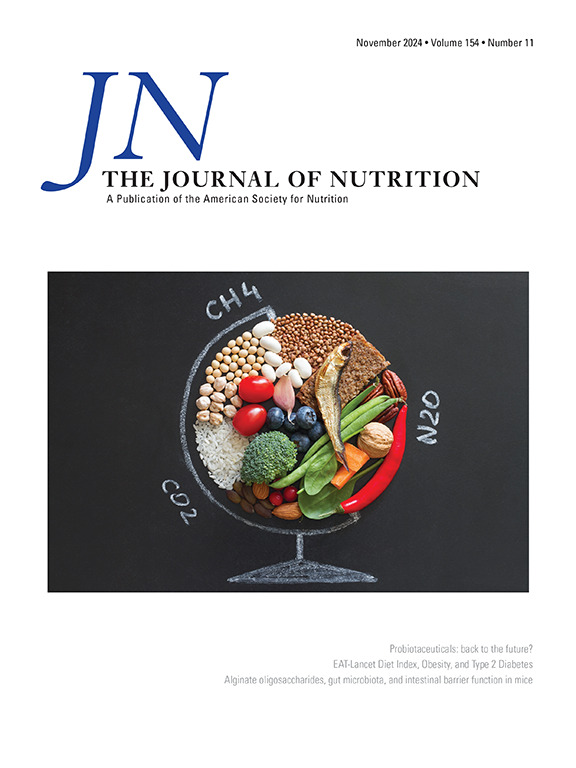Polyphenol Intake and Risk of Dementia and Cognitive Decline in Older Adults: Principal Component Analysis Approach
IF 3.7
3区 医学
Q2 NUTRITION & DIETETICS
引用次数: 0
Abstract
Background
Polyphenols have been associated with brain health, but their impact on humans, especially in combinations, has been less explored.
Objective
This study aimed to investigate the association between dietary polyphenol patterns (PPs), dementia incidence, and cognitive changes over time in the elderly.
Methods
A total of 1041 individuals without dementia (mean age 73.1, standard deviation [SD] = 4.9) were followed longitudinally. Participants provided baseline dietary data via a validated food frequency questionnaire. Dementia was diagnosed through clinical and neuropsychological evaluations, and cognitive performance was assessed using a neuropsychological battery. Principal component analysis of 11 polyphenol classes identified 3 distinct PPs. Generalized Estimating Equations assessed cognitive decline rates, whereas Cox regression models evaluated dementia risk, adjusting for covariates such as age, sex, education, energy intake, physical activity, smoking, alcohol consumption, hypertension, diabetes mellitus, stroke history, coronary disease, and baseline mild cognitive impairment.
Results
Over the follow-up period of 3.0 y (SD = 0.8), 62 participants developed dementia. The PPs explained up to 77.4% of the variance. The third polyphenol pattern (PP3), characterized by lignans, flavonols, and isoflavonoids, predominantly provided by cruciferous vegetables, pulses, and leafy vegetables, was associated with a slower rate of cognitive decline. A 1-unit increase in PP3 intake was associated with 0.9% of a SD less decline per year in the global cognitive score (β = 0.009; 95% confidence interval [CI]: 0.000, 0.017, P = 0.041). For incident dementia, participants in the third quartile of PP3 had a 71% lower risk than those in the first quartile (hazard ratio [HR]: 0.29; 95% CI: 0.12, 0.67, P-trend = 0.018). No significant associations were observed for the other PPs.
Conclusions
A PP high in lignans, flavonols, and isoflavonoids was associated with a reduced risk of dementia and cognitive decline in elderly Greeks. These findings offered encouraging evidence for combined polyphenol intake, suggesting further validation in different population samples.
希腊老年人多酚摄入与痴呆和认知能力下降的风险:主成分分析方法。
背景:多酚与大脑健康有关,但它们对人类的影响,特别是组合使用时的影响,研究较少。目的:本研究旨在探讨膳食多酚模式(PPs)与老年痴呆发病率和认知变化之间的关系。方法:对1041例非痴呆患者(平均年龄73.1岁,SD=4.9)进行纵向随访。参与者通过有效的食物频率问卷提供基线饮食数据。痴呆症通过临床和神经心理学评估进行诊断,认知表现通过神经心理学电池进行评估。11个多酚类的主成分分析鉴定出3种不同的PPs。广义估计方程评估认知能力下降率,而Cox回归模型评估痴呆风险,调整协变量,如年龄、性别、教育程度、能量摄入、体力活动、吸烟、饮酒、高血压、糖尿病、中风史、冠心病和基线轻度认知障碍。结果:在3.0年(SD=0.8)的随访期间,62名参与者出现痴呆。PPs解释了高达77.4%的差异。第三种多酚模式(PP3)以木脂素、黄酮醇和异黄酮为特征,主要由十字花科蔬菜、豆类和叶类蔬菜提供,与认知能力下降的速度较慢有关。PP3摄入量每增加一个单位,全球认知评分每年下降0.9%的标准差(β =0.009, 95% CI [0.000-0.017], p= 0.041)。对于痴呆的发生,PP3的第三个四分位数的参与者比第一个四分位数的参与者的风险低71% (HR = 0.29, 95% CI [0.12-0.67], p = 0.018为趋势)。其他多酚类型未观察到显著关联。结论:富含木脂素、黄酮醇和异黄酮的PP与老年希腊人患痴呆和认知能力下降的风险降低有关。这些发现为联合多酚摄入提供了令人鼓舞的证据,表明在不同人群样本中进一步验证。
本文章由计算机程序翻译,如有差异,请以英文原文为准。
求助全文
约1分钟内获得全文
求助全文
来源期刊

Journal of Nutrition
医学-营养学
CiteScore
7.60
自引率
4.80%
发文量
260
审稿时长
39 days
期刊介绍:
The Journal of Nutrition (JN/J Nutr) publishes peer-reviewed original research papers covering all aspects of experimental nutrition in humans and other animal species; special articles such as reviews and biographies of prominent nutrition scientists; and issues, opinions, and commentaries on controversial issues in nutrition. Supplements are frequently published to provide extended discussion of topics of special interest.
 求助内容:
求助内容: 应助结果提醒方式:
应助结果提醒方式:


